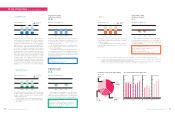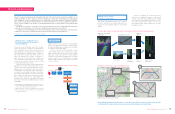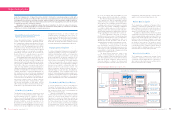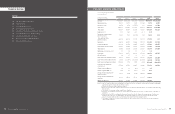Pioneer 2015 Annual Report Download - page 17
Download and view the complete annual report
Please find page 17 of the 2015 Pioneer annual report below. You can navigate through the pages in the report by either clicking on the pages listed below, or by using the keyword search tool below to find specific information within the annual report.the expected future tax consequences of temporary
differences between the carrying amounts and the
tax bases of assets and liabilities. Deferred taxes are
measured by applying currently enacted tax laws to
the temporary differences. A valuation allowance is
established to reduce deferred tax assets if they are
not considered to be recoverable.
q. Foreign Currency Translations
All short-term and long-term monetary receivables
and payables denominated in foreign currencies are
translated into Japanese yen at the exchange rates
at the consolidated balance sheet date. The foreign
exchange gains and losses from translation are rec-
ognized in the consolidated statement of operations
to the extent that they are not hedged by forward
exchange contracts.
r. Foreign Currency Financial Statements
The balance sheet accounts of the consolidated for-
eign subsidiaries are translated into Japanese yen
at the current exchange rate as of the consolidated
balance sheet date, except for equity, which is trans-
lated at the historical rate. Differences arising from
such translations are shown as “Foreign currency
translation adjustments” and “Minority interests” in
a separate component of equity. Revenue and ex-
pense accounts of consolidated foreign subsidiaries
are translated into yen at the average exchange rate.
s. Derivatives and Hedging Activities
The Group uses derivative financial instruments
to manage its exposures to fluctuations in foreign
exchange and interest rates. Foreign exchange for-
ward contracts and currency swaps are utilized by
the Group to reduce foreign currency exchange and
interest rate risks associated with assets and liabilities
denominated in foreign currencies and debt obliga-
tions. The Group does not enter into derivatives for
trading or speculative purposes.
Derivative financial instruments and foreign cur-
rency transactions are classified and accounted for
as follows: (a) all derivatives are recognized as either
assets or liabilities and measured at fair value, and
gains or losses on derivative transactions are rec-
ognized in the consolidated statement of operations
and (b) for derivatives used for hedging purposes,
if such derivatives qualify for hedge accounting be-
cause of high correlation and effectiveness between
the hedging instruments and the hedged items, gains
or losses on derivatives are deferred until maturity of
the hedged transactions.
Foreign currency forward contracts, currency op-
tions and currency swaps are utilized to hedge foreign
currency exposures in export sales and procurements
reasonable estimate of the asset retirement obligation
cannot be made in the period the asset retirement ob-
ligation is incurred, the liability should be recognized
when a reasonable estimate of asset retirement obliga-
tion can be made. Upon initial recognition of a liability
for an asset retirement obligation, an asset retirement
cost is capitalized by increasing the carrying amount
of the related fixed asset by the amount of the liability.
The asset retirement cost is subsequently allocated to
expense through depreciation over the remaining useful
life of the asset. Over time, the liability is accreted to its
present value each period. Any subsequent revisions
to the timing or the amount of the original estimate of
undiscounted cash flows are reflected as an increase or
a decrease in the carrying amount of the liability and the
capitalized amount of the related asset retirement cost.
n. Research and Development Costs and
Intangible Assets
Research and development costs are charged to in-
come as incurred. Software for sale is amortized by
the straight-line method over 1–3 years, while soft-
ware for internal use is amortized by the straight-line
method over the estimated useful life of five years.
Intangible assets other than software are amortized
using the straight-line method.
o. Leases
The depreciation method for lease assets involving
finance lease transactions of which the ownership
is transferred to lessees is the same as that which
applies to property, plant and equipment owned by
the Company.
The depreciation method for lease assets involv-
ing finance lease transactions of which the ownership
is not transferred to lessees is the straight-line method
with their residual values being zero over their leased
periods used as the number of years for useful life.
In March 2007, the ASBJ issued ASBJ Statement
No. 13, “Accounting Standard for Lease Transactions,”
which revised the former accounting standard for
lease transactions issued in June 1993, and ASBJ
Guidance No. 16, “Guidance on Accounting Standard
for Lease Transactions,” which revised the former
guidance issued in January 1994. The adoption of
the revised accounting standard was permitted for
fiscal years beginning on or after April 1, 2008.
All other leases are accounted for as operating
leases.
p. Income Taxes
The provision for income taxes is computed based on
the pretax income included in the consolidated state-
ment of operations. The asset and liability approach is
used to recognize deferred tax assets and liabilities for
from overseas suppliers. Trade receivables and trade
payables denominated in foreign currencies are trans-
lated at the contracted rates if the foreign currency
forward contracts, currency options and currency
swaps qualify for hedge accounting.
The interest rate swaps which qualify for hedge
accounting and meet specific matching criteria are
not remeasured at market value but the differential
paid or received under the swap agreements are rec-
ognized and included in interest expense or income.
t. Per Share Information
Basic net income per share is computed by divid-
ing net income available to common shareholders by
the weighted-average number of shares of common
stock outstanding for the period, after deduction of
treasury stock, retroactively adjusted for stock splits.
Diluted net income per share for the years ended
March 31, 2015 and 2014, is not disclosed as there
were no potentially dilutive securities for the years
ended March 31, 2015 and 2014.
Diluted net income per share reflects the potential
dilution that could occur if securities were exercised
or converted into common stock. Diluted net income
per share of common stock assumes full conversion
of the outstanding convertible notes and bonds at the
beginning of the year (or at the time of issuance) with
an applicable adjustment for related interest expense,
net of tax, and full exercise of outstanding warrants.
Cash dividends per share presented in the ac-
companying consolidated statement of operations
are dividends applicable to the respective years in-
cluding dividends to be paid after the end of the year.
u. New Accounting Pronouncements
Accounting Standards for Business Combinations
and Consolidated Financial Statements —
On September 13, 2013, the ASBJ issued revised
ASBJ Statement No. 21, “Accounting Standard for
Business Combinations,” revised ASBJ Guidance
No. 10, “Guidance on Accounting Standards for Busi-
ness Combinations and Business Divestitures,” and
revised ASBJ Statement No. 22, “Accounting Stan-
dard for Consolidated Financial Statements.”
Major accounting changes are as follows:
(a) Transactions with noncontrolling interest — A par-
ent’s ownership interest in a subsidiary might change
if the parent purchases or sells ownership interests in
its subsidiary. The carrying amount of minority interest
is adjusted to reflect the change in the parent’s owner-
ship interest in its subsidiary while the parent retains its
controlling interest in its subsidiary. Under the current
accounting standard, any difference between the fair
(c) The revised accounting standard also made certain
amendments relating to the method of attributing ex-
pected benefit to periods and relating to the discount
rate and expected future salary increases.
This accounting standard and the guidance for (a) and
(b) above are effective for the end of annual periods
beginning on or after April 1, 2013, and for (c) above
are effective for the beginning of annual periods be-
ginning on or after April 1, 2014, or for the beginning
of annual periods beginning on or after April 1, 2015,
subject to certain disclosure in March 2015, both with
earlier application being permitted from the begin-
ning of annual periods beginning on or after April 1,
2013. However, no retrospective application of this
accounting standard to consolidated financial state-
ments in prior periods is required.
The Company applied the revised accounting stan-
dard and guidance for retirement benefits for (a) and
(b) above, effective March 31, 2014, and for (c) above,
effective April 1, 2014.
With respect to (c) above, the Company changed the
method of attributing the expected benefit to periods
from a straight-line basis to a benefit formula basis,
the method of determining the discount rate from using
the period which approximates the expected average
remaining service period to using a single weighted av-
erage discount rate reflecting the estimated timing and
amount of benefit payment, and recorded the effect of
(c) above as of April 1, 2014, in “Retained earnings.”
As a result, “Accrued pension and severance costs”
as of April 1, 2014, decreased by ¥812 million ($6,767
thousand), and “Retained earnings” as of April 1, 2014,
increased by ¥796 million ($6,633 thousand). The ef-
fect of this accounting change on net income, net
assets per share and net income per share as of and
for the year ended March 31, 2015 was immaterial.
m. Asset Retirement Obligations
In March 2008, the ASBJ published ASBJ Statement
No. 18 “Accounting Standard for Asset Retirement Ob-
ligations” and ASBJ Guidance No. 21 “Guidance on
Accounting Standard for Asset Retirement Obligations”.
Under this accounting standard, an asset retirement
obligation is defined as a legal obligation imposed ei-
ther by law or contract that results from the acquisition,
construction, development and the normal operation of
a tangible fixed asset and is associated with the retire-
ment of such tangible fixed asset. The asset retirement
obligation is recognized as the sum of the discounted
cash flows required for the future asset retirement
and is recorded in the period in which the obligation
is incurred if a reasonable estimate can be made. If a
30 Pioneer Corporation Annual Report 2015 31
Pioneer Corporation Annual Report 2015
























